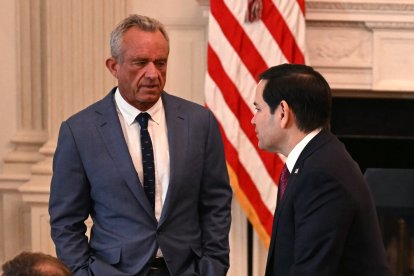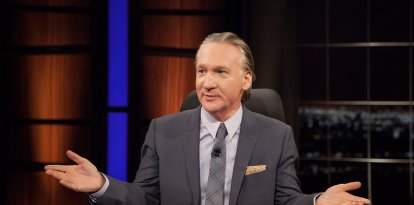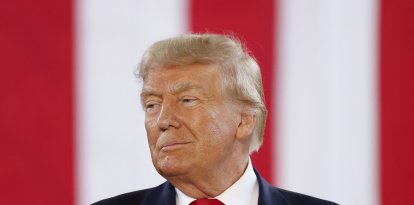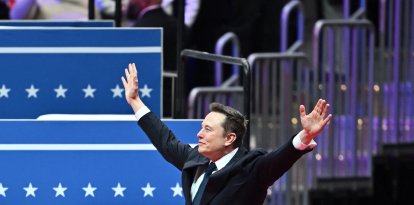The most and least liked cabinet members
Health Secretary Robert F. Kennedy Jr. is the highest rated cabinet member by Americans, while his State Department counterpart, Marco Rubio, received the most support among senators.

Secretaries Robert F. Kennedy Jr (health) and Marco Rubio (state).
After a string of key votes in the Senate, the cabinet is filling up with names. Now a month old, the Trump administration succeeded in confirming 18 of the president's 22 nominees. Four more for a clean sweep.
Marco Rubio got the first confirmation on the same day as Trump's inauguration, becoming secretary of state thanks to the unanimous vote. The State Department was followed by the Departments of Interior, Agriculture, Justice, and in the last few hours, the Federal Bureau of Investigation (FBI). Kash Patel will take the helm at the agency after passing his vote by a tight margin.
Once in office, nominees take on the mission of serving the president to implement his plan in each of the departments they head. If they fall from grace in the eyes of the president, they will join the long list of people to hear Trump's iconic, "You're fired!" But at the same time, they must look after their popularity in the eyes of the citizens and in politics, as well as to serve out their term, and perhaps aspire to the Oval Office in 2028.
Kennedy, the people's favorite
The latest survey from Harvard CAPS-Harris shows Robert F. Kennedy Jr. as the most popular nominee among the American public with a 44% favorable image.
The poll released in January asked, specifically, for each figure and his or her role, "Do you favor or oppose each of the following cabinet appointments made by president-elect Trump?" That is, respondents applaud that the environmental lawyer was specifically selected for the position of health secretary, a choice that at first seemed one of the most controversial.
Although pollsters did not dig into motives, Kennedy's pledge to Make America Healthy Again may explain, in part, this favorable position. His personal image (considering only his figure, leaving aside his office) may shed another bit of light: 45% of Americans view him favorably, as revealed by another section of the poll. In that last one he is also placed in the podium of best-valued figures, behind Barack Obama and Donald Trump.
His presidential run may have helped stoke his popularity, especially considering that none of his cabinet counterparts campaigned under their own name. Kennedy enjoyed high popularity ratings, even if he did not take off from third place.
It may also explain why only 21% of Americans shrug their shoulders when asked about his suitability for office. This indifference is seen with other elected officials: the most extreme case is Lee Zeldin, about whom 48% do not know what to think. Close behind are Kristi Noem, with 41% don't know/no answer, and Pete Hegseth, with 37%.
Having been part of both political parties while also spending a stint as an independent could have served to win him supporters across party lines. In fact, he is, according to the same survey, the nominee best valued by both Democrats (23% support his election) and independents (40%) and Republicans (although Elon Musk beats him by 1 point, the latter being part of the administration but not of the cabinet).
That a nominee is well rated by the citizens, however, does not mean that the same is true among his political colleagues. A good case in point is RFK Jr., at the head of public opinion outside the Capitol, but at the tail end inside.
Rubio, the senators' favorite
Marco Rubio was not only the first to obtain the more than 50 votes needed in the Senate, but he is also the one who achieved the best record: 99 votes in favor, zero against. The former senator with Cuban roots is, so far, the only nominee to have obtained full bipartisan support on the floor of the Senate.
All of Trump's nominees who underwent the double Senate vote passed both tests. For a Cabinet nominee to be confirmed in office, they must pass a vote in a relevant committee and then another on the floor. To do this, they undergo confirmation hearings, where they must answer questions from senators who will then give or reject their vote.
Rubio, for example, first had to submit to the questions and vote of the members of the Foreign Relations Committee, in a hearing that he passed comfortably. It was then approved by an absolute majority of senators. Not all roads were so comfortable.
Pete Hegseth navigated the most turbulent confirmation: Vice President J.D. Vance, as Senate president, had to break a tied 50-50 vote from lawmakers. Three Republicans joined all Democrats and two independents in jeopardizing the future of the war veteran as secretary of defense.
Lisa Murkowski (R-Ala.), Susan Collins (R-Maine) and Mitch McConnell (R-Ky.) were the three GOP members who rejected Hegseth. They questioned his lack of credentials at the helm of large teams, as well as character, citing a drinking past, sexual harassment allegations and suspicions of financial mismanagement.
Although the now brand-new secretary received the most negative votes from the GOP, he was not the only one. Kash Patel got two. The no votes there were repeated: Lisa Murkowski and Susan Collins. McConnell, meanwhile, again broke off from the GOP on two occasions, voting "no" alone against Gabbard and Kennedy Jr.
Loyalty within the party is a key signal for a White House that enjoys a bare-minimum majority as it tries to push its agenda forward.
Stepping on the gas in the Senate
During his first term, the GOP secured two confirmations in the first 24 hours (James Mattis, former defense secretary; John Kelly, former DHS secretary), beating out one from 2025 (Rubio). However, in Ballotpedia's "Global Computation," he is ahead of his 2017 pace.
The speed of confirmations responds to multiple factors, including whether the government of the has a majority, whether the position to be held is more or less controversial... And the candidate themself.
A long way ahead
The approval of the administration's top officials will fluctuate as they make decisions at the head of the agencies.
For example, a mid-February poll from Marquette University shows Marco Rubio slightly improving his image (+4%) in less than a month. While Kennedy's has worsened (-5%) and Pete Hegseth's and Pam Bondi's remain virtually unchanged.
Those fluctuations occurred in less than a month. How many can occur in four years?
The answer is key to the success or failure of the administration, since the polling performance of the cabinet is both a diagnostic of the popularity of its measures and a tool for carrying out its agenda. And for the department heads themselves, especially if they want to position themselves as possible presidential candidates.
The government team has several members bordering on or under 50 and is seen as a quarry from which heirs to party leadership could emerge. Trump cannot run in 2028. Rumors about who will be his successor have begun to be heard. The answer may be in the cabinet.
RECOMMENDATION






















